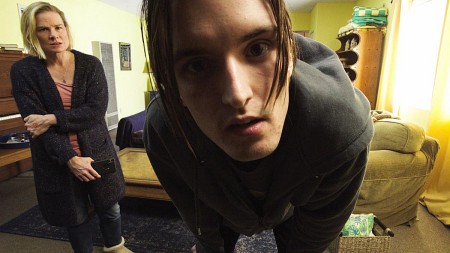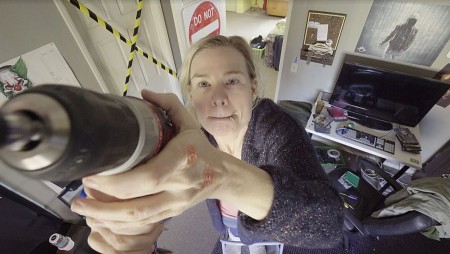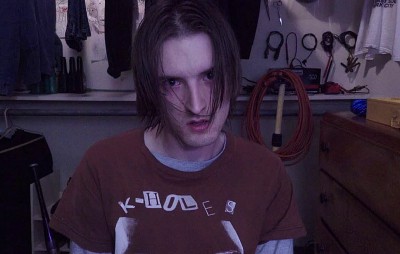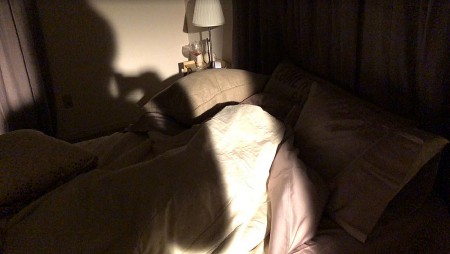|
Your new movie M.O.M.
Mothers of Monsters - in a few words, what is it about?
M.O.M.
Mothers of Monsters
is a psychological thriller about a mother who suspects her son is a
psychopath who may be plotting a school shooting. When he outsmarts the
system, she sets up an elaborate spy cam system in their home to figure
out if heís just a typical hormonal teenager or if he is actually
capable of murder.
What were your sources of inspiration when writing M.O.M.
Mothers of Monsters?
Iíve
always been a big fan of the horror/thriller genre, especially when the
premise is seeded in truth. Well one of the tragic truths we, as a
society, are facing right now is an epidemic of youth violence in this
country. The 2012 shooting at Sandy Hook Elementary in Connecticut was a
real wake-up call for me because that was the same school my niece almost
attended, which would have put her in the same classroom, at the same
time, when a former student went on a shooting spree and killed twenty-six
people. Despite the overwhelming sense of horror we all feel in the
aftermath of a mass shooting, the divisive state of this country has
rendered us completely incapable of enacting change. Weíve allowed it to
become a political argument over gun reform and healthcare and I believe
our inaction ultimately condones these acts of violence. Iím not a
politician, but as a filmmaker I felt the need to keep this crisis seared
into our collective consciousness as much as possible. I mean, this movie
is not about a school shooter. It is about the fundamental breakdown of
communication within a uniquely American family. It is about the
deterioration of the human psyche that has the propensity to produce a
school shooter. First and foremost,
M.O.M.
Mothers of Monsters is a very disturbing work of
narrative fiction, but a lot of the character traits, events and dialogue
was borrowed from the journals, manifestos and memoirs of real-life school
shooters and their parents. Itís my favorite kind of film: a real-life
horror.
To what extent can you actually personally identify with Abbey?
And while we're at it, to what extent with her son Jacob? Iím
not a mother myself but I think a lot of us can identify with what itís
like to have a family member who we both love and fear at the same time.
Whether thatís a disciplinarian parent or a kid with a real mean streak,
most of us have had some kind of exposure to someone who canít manage
their emotions to the point of being harmful to others. Our culture is
changing, weíre becoming more and more isolated - and our kids arenít
learning basic coping skills or how to deal with real-life conflicts
anymore. When I was a teen, we used to talk at the dinner table or after
watching a movie together, but with everyoneís face buried in their smart
phones now, we forget how important talking to each other really is. We
forget how important listening is. We are replacing real human interaction
with simulated pleasure, that millisecond rush of endorphins we get when
someone likes us on Facebook or Twitter or Instagram or Snapchat. As
youíll see in the film, not only is Jacob addicted to technology but
Abbey herself ends up having a much more intimate relationship with her
devices than she does with her own son. I think all of us can relate to
that on some level Ė this film just takes it to the most horrifying
conclusion of all.
 |
What
can you tell us about M.O.M.
Mothers of Monsters' approach to horror? Horror
is about fear, right? We get scared, we get a jolt of adrenaline, we feel
alive, we come back for more. Why not give people something to think about
in the process? There are plenty of real horrors going on around us every
single day. I mean donít get me wrong, I enjoy a good slasher film now
and again, but the chance of a killer doll springing to life and gnawing
my head off my neck is a lot less likely than the chance of a disgruntled
employee mowing me down with an AR 15 on Friday afternoon. Real life
scares me more than anything else so that is whatís naturally reflected
in my work as a filmmaker. You
shot M.O.M.
Mothers of Monsters found footage-style - so what made you choose
that approach, and what are the advantages and challenges shooting that
way? Found
footage is a brilliant mechanism of filmmaking if you use it right. And
using it right has everything to do with giving the characters a
believable reason to be filming in the first place. Documentarians
disappearing in the woods while hunting down a legendary witch was a
ground-breaking concept at the time of The
Blair Witch Project. Capturing photographic
evidence of a supernatural presence worked quite well for Paranormal
Activity. I wanted to evoke that same kind of fear without relying on
anything paranormal, so the premise of the film had to be anchored in
absolute authenticity. What better hook than a mother whoís forced to
outfit her entire house with spy cameras to figure out if her son is
really a psychopath or not? The monster in this movie is human, and itís
the kind of monster weíre seeing on the news every week in this country.
The
challenges of making this particular film had a lot to do with the fact
that I am a found footage junkie. I respect the format immensely, which
meant I was unwilling to make exceptions when it came to upholding the
integrity of this subgenre. For example, true found footage films are not
musically scored and of course music is what filmmakers use to drive the
emotional pacing of a movie. Well, all the music in
M.O.M.
Mothers of Monsters is organically
sourced, meaning itís something playing in the background on the radio,
or television, or what Jacob is listening to during the actual scene
itself. So we had to find all this music prior to shooting and play it
live in-scene when the cameras were rolling. We were lucky enough to work
with an incredible alternative hip-hop artist named Salvatore Siciliano
before principal photography started, who not only worked with us to
identify the type of music Jacob would listen to, but even wrote several
songs catering the lyrics to Jacobís individual psychosis. We used his
most masterful song of all, titled Wonít Stop as the theme music
for the film, which plays out in its entirety under the credits.
|

|
The
advantages of shooting a found footage film typically has to do with
budget, because in most cases you donít need expensive cameras or a full
crew - but that was not the case for us. We used so many surveillance cameras
(sometimes up to 6 in a single scene), that to maintain the vision I had
for each one required bringing on a director of photography with a truly
exceptional eye for detail. I mean, all these cameras were pre-mounted
into ceilings and bookshelves
and doorways - so if a single one was repositioned even a fraction of a
millimeter differently than it was the day before, weíd have a giant
continuity issue on our hands. Our director of photography, Matt Paulsen,
ended up camping out in our picture house for months on end because the
time it took to break down and then reset each camera became unmanageable.
Heís really the unsung hero of this entire film actually.
M.O.M.
Mothers of Monsters was mostly shot in just one location - so
where was it shot, what was it like shooting there, and what were some of
your techniques to keep things visually interesting within this
limitation?
Yeah,
other than a few scenes shot on a high school campus or a local
electronics store, the majority of the film takes place inside this
familyís home. We chose a house in Long Beach, California that had a
similar layout to the hero house depicted in the original screenplay. Of
course, the film takes place in suburban Ohio, so a lot of time and effort
went into re-envisioning the entire layout and furnishing it to match the
dťcor of a modest home that could be found somewhere in Northeast
America. This required us to work very closely with our genius art director, Deboriah Dupree, who redesigned every single room on a 3D
software program so we could simply move graphic elements around before
spending our limited budget on actual renovations.
To
keep the space visually interesting we painted each of the rooms with a
bold & distinct color, which helped the scenes resonate emotionally
and also oriented the audience as to where each of the spy cameras were
hidden. The color palette of the film very purposefully reflects the
subject matter itself. For example, we painted the kitchen a striking lime
green, which is the national color of Mental Health Awareness. This
eventually becomes the dominant color of the whole film and is
incorporated into every scene in both set design and wardrobe. The more
the characters begin to unravel the more lime green appears - in dishware,
pillows, fruit bowls, wardrobe and overall set design. We chose to paint
the walls of the living room a bright yellow, because in film this color often
represents dishonesty, deceit, danger (specifically ďhazardĒ), and
becomes the room where Jacob throws his first tantrum. The entryway is
painted fire orange, the color that has come to symbolize National Gun
Violence Awareness and is worn across the country in rallies and marches.
We labored over every single detail of the set design, and although we
donít expect most audiences to pick up on all that, it anchors the film
in the kind of authenticity we wanted to maintain on every level.
 |
What can you tell us about your overall
directorial approach to your story at hand?
I
have a background in documentary television, so this informed my approach
to the storytelling because I wanted this film to feel real and unpolished
like a documentary. I needed it to be gritty and uncomfortably voyeuristic
so the audience had that sense of peeking through a keyhole into the
intimate life of someone elseís dysfunctional family.
Of
course,
M.O.M.
Mothers of Monsters is a work of narrative fiction and I was working with
actors, so I had to inspire them to completely reinvent their relationship
to the material. I incorporated what was eventually
dubbed on set as the ďdocumentary takeĒ, which meant after the actors
finished their interpretation of a scene, I would ask them to forget all
their training and deliver their lines again as simply as possible.
Thatís actually a very difficult thing for talented actors to do because
it seems very counterintuitive to all the work theyíve done to prepare
for the role. I mean, theyíve spent a lot of time and energy finding the
motivation behind every line and here I am barking things like ďthrow
it away!Ē or ďdonít make that line mean anything at all!Ē
Eventually, this technique paid off and the film has that
documentary-style, slice-of-life feel that I had originally envisioned.
Do talk
about your cast, and why exactly these people?
About
two months into auditioning actresses to play Abbey, we realized that the
caliber of talent this role required was going to be a lot harder to find
than we ever realized. Our producers eventually managed to get the
screenplay into the hands of Melinda Page Hamilton (Messiah,
Mad Men, Damnation, How To Get Away With
Murder), and she showed up to our first
meeting with a stack of folders including some of the same newspaper
clippings and articles I had used to write the script. I instantly knew
she was connecting with the material in both a profoundly personal and
intellectual way. When we saw her first reading, we were blown away by
Melindaís interpretation of who this mother was at her very core - and
some of the bold choices she made expanded my own understanding of film.
We
had originally wanted to cast a recognizable name to play the role of
Jacob, but no one quite fit the bill. We ended up watching hundreds of
digital auditions and Bailey Edwards [Bailey
Edwards interview - click here] became a favorite early on. He had
that striking ability to embody a complicated teenager who emotes both a
chilling sense of terror and irresistible charm at the same time. The
callbacks and chemistry reads took several more months but Bailey managed
to keep the same material feeling fresh and unpredictable every single
time, which is something I always look for in an actor. It wasnít until
after we officially offered Bailey the part that he told us his father is
Anthony Edwards, which I thought was a really standup way to land a
starring role based solely on his own merit.
A few
words about the shoot as such, and the on-set atmosphere? Most
of the film crew, including all the dept. heads, were female, which
created a very collaborative working environment on set. Plus, the two
lead actors (Melinda and Bailey), happen to know every lyric to every
musical in the history of Broadway, so every time we cut cameras to reset a
scene, the two of them would simultaneously burst into a very lively song
and dance number. Given the deeply disturbing subject matter of this film,
and the fact that they were wearing make-up so as to appear utterly
exhausted and malnourished, the set would instantly transform into some
kind of harmonious zombie apocalypse duet, which often gave me pause as to
whether I should switch gears and make an entirely different kind of film. The
$64 question of course, where can your movie be seen? Itís
playing at the Arena Cinelounge Theater in Hollywood from March 13th to
March 22nd, but with the outbreak of the Coronavirus weíre now
encouraging people to stay home and watch it on Amazon instead:
https://www.amazon.com/exec/obidos/ASIN/B08439ZWH2/
Anything
you can tell us about audience and critical reception of M.O.M.
Mothers of Monsters?
Well
my biggest fear was that some people might misinterpret the intentions of
this film and assume I was somehow sensationalizing the sensitive subject
matter it deals with. I mean, how would they know that such a painstaking
amount of research went into this project or that the script was vetted by
mental health organizations? But I have to say, weíve been very
impressed with the critical reception thus far because people are truly
getting what the essence of this movie is about. I mean, this is a very
confronting film, and itís a psychological thriller with a horrific
twist at the end so people arenít exactly walking out of the theater
with smiles on their faces. But theyíre posting about it on their social
media accounts and theyíre recommending it to their friends - and
talking about this epidemic of violence thatís rocking the consciousness
of this country is exactly why I wanted to make a controversial film
like this in the first place. People really seem to be paying attention
and Iím enormously grateful for that.
 |
Any future projects you'd
like to share? I
always have a ton of projects on my radar but Iím very passionate about
what I work on, which limits my ability to focus on more than one project
at a time. Iím working on an A&E documentary series right now but
when we wrap towards the end of 2020, Iíd like to spend some time on a
feature documentary Iíve been filming off and on since 2013 (Cracked)
about my mentally ill, drug addicted, homeless older sister who is trying
to reconnect with the ten children she lost custody of before she dies. I
havenít figured out a log line for that one yet! At some point, Iíd
also like to revisit my first screenplay, titled Halfbreed, which was one
of the winners in the horror category of the PAGE International
Screenwriting Awards. From what I know, you've entered the
filmworld as a TV producer - so what can you tell us about that ascpect of
your career?
Iíve
been directing unscripted television shows for many years and have
especially enjoyed working on paranormal series like Fact or Faked:
Paranormal Files, Ghosts of Shepherdstown, and Ghosts of Morgan
City.
Iíve always been intrigued by the unknown, but I didnít want to get
pigeonholed into paranormal television or documentary filmmaking. At
heart, Iíve always been a writer & filmmaker, so I decided it was
time to take that leap and make my first feature film. Thereís a lot
more time to refine the craft of storytelling with narrative fiction, to
visualize what it is youíre trying say and how exactly youíre going to
say it. My experience in television certainly leant itself to the
technical side of making a film and I had the huge advantage of partnering
with powerhouse producers, Elaine White and Austin Porter, who had pulled
off miracles for me in the past. But I had to rely on an entirely
different side of my brain to make a
movie.
I had to turn inward, reflect, and use my imagination in a way that made
me feel more alive than anything else Iíve ever done.
What made you branch out into directing
eventually, and did you receive any formal education on the subject? I
studied film and theater in Emerson College and then moved into writing
and directing theatrical plays. I started taking side jobs on television
productions to pay the bills but it wasnít until I saw what my scripts
turned in to at the hands of other directors who didnít share my vision,
that I realized I was way too much of a control freak to sit on the
sidelines!
How would you describe
yourself as a director? My
strength is working with actors so Iím more of a performance director
than anything else. Of course, Iím also the writer so I always have a
very clear vision of what I want from day one, but thatís never
interfered with my ability to recognize a genius creative choice when I
see one. I mean, thereís nothing more rewarding than watching a truly
gifted actor discover those nuances that give their character more
dimension and depth than I could have possibly imagined. I think playing
and experimenting and improvising during rehearsals is key when it comes
to carving out what makes a character really tick. I jot things down a lot
during rehearsals and if something works better than whatís in my
script, I change it and print out a new script the next day. During the
filming of this movie there were a few scenes with Abbey that were so
emotionally raw, the only way we could get to the scripted lines was to
let Melinda improvise her way there (her idea actually, and a brilliant
one at that!). Iím also an editor and spent a lot of time in post on
M.O.M.
Mothers of Monsters - so I knew in advance that for this particular scene I could use a
montage of jump cuts to tell the story I wanted to tell. I think itís
important to collaborate as much as possible on a film set, as long as you
have the technical understanding to know you only have to use what truly
enhances your original vision of the film in the end. Filmmakers who inspire you? Patty
Jenkins (Monster), Lynne Ramsay (We Need to Talk About Kevin), Kimberly
Peirce (Boys Donít Cry) Yorgos Lanthimos (Dogtooth, The Killing of a
Sacred Deer, The
Favourite) and Sophia Coppola (The Virgin Suicides, Lost
in Translation). Your
favourite movies? Depends
where Iím at in life but Iíd say Sophieís Choice, City of
God,
Napoleon Dynamite, Let the Right One In (2008 original),
Monster, and Boys
Donít Cry have certainly made a lasting impression. ... and of course, films you really
deplore? I
always find something to appreciate in every film I watch but the few I
never quite got into were Kill Bill
(1 or 2),
Irrťversible and maybe
Showgirls (although I never even made it through that one). Your/your movie's website, Facebook, whatever
else? Website:
https://www.mothersofmonsters.com/ Facebook:
@M.O.M.movie Instagram:
m.o.m.movie Twitter: @MomsOfMonsters Anything else you're dying to mention and I have
merely forgotten to ask?
 |
Feeling lucky?
Want to
search
any of my partnershops yourself
for more, better results?
(commissions earned) |
The links below
will take you
just there!!!
|
|
 |
Well,
one thing I should mention is that some critics are starting to use the
word ďcult classicĒ for this film because there are so many layers of
story & hidden meanings throughout. Thereís a long trail of Easter
Eggs that were meticulously planned in advance that I would never expect
most viewers to get in one sitting. Some of them are not important to the
story itself, like the characterís last name being ďBellĒ, which is
the symbol of hope for those affected by mental illness (look it up
because itís actually a pretty cool story). Or the fact that the whole
film takes place during the month of May - national mental health
awareness month. But there are a lot of other clues and messages that are
integral to the story and will enhance the overall experience in a pretty
remarkable way. If someone only plans on seeing
M.O.M.
Mothers of Monsters once, then Iíd
encourage them to really pay attention, to listen to the audio design, to
appreciate the nuances the actors are signaling, to look for signs, to be
vigilant. Thanks for the interview!
Holy
cow, your questions made me think, thank YOU!
|